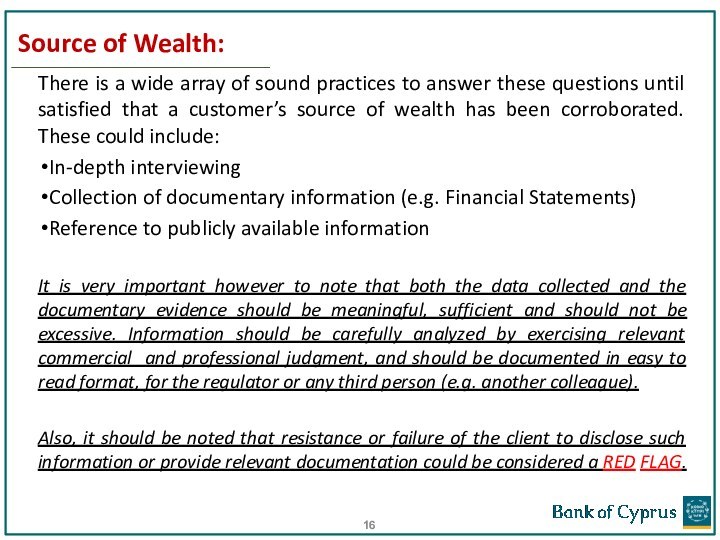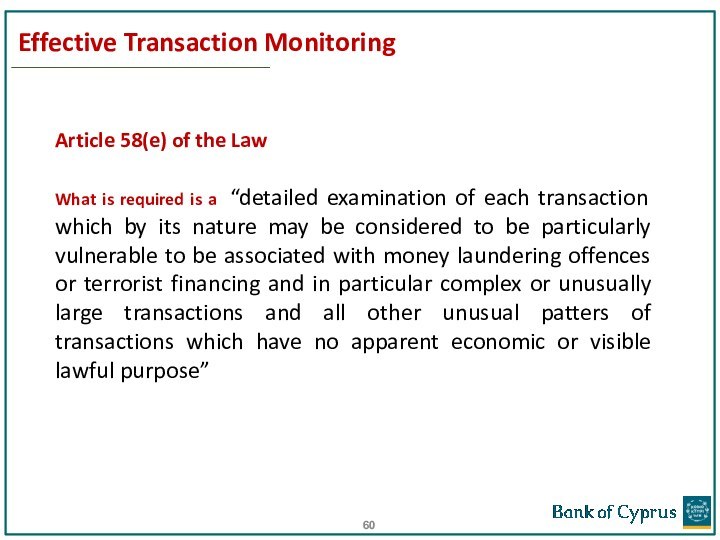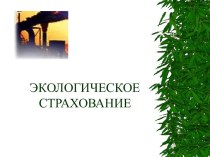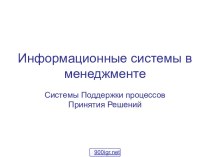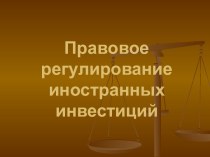Слайд 2
Schedule:
Money Laundering Defined
Effective Due Diligence – Know
your Client
Trusts – Foundations - Complex Structures
Politically Exposed Persons
- Private Banking
ML in Real Estate – Trade Based ML
Professional Intermediaries – Business Associates
Sanctions Compliance
Terrorist Financing
Effective Transaction Monitoring
Customer Review Process
Suspicious Activity Reports
Closing Remarks – Conclusion
Слайд 3
Money Laundering Defined
When committed intentionally, Money Laundering, is

defined as:
the conversion or transfer of property, knowing that
such property is derived from criminal activity or from an act of participation in such activity, for the purpose of concealing or disguising the illicit origin of the property or of assisting any person who is involved in the commission of such an activity to evade the legal consequences of that person's action;
the concealment or disguise of the true nature, source, location, disposition, movement, rights with respect to, or ownership of, property, knowing that such property is derived from criminal activity or from an act of participation in such an activity;
the acquisition, possession or use of property, knowing, at the time of receipt, that such property was derived from criminal activity or from an act of participation in such an activity;
participation in, association to commit, attempts to commit and aiding, abetting, facilitating and counselling the commission of any of the actions referred to in points (a), (b) and (c).
(4th EU AML Directive)
Слайд 4
The stages of Money Laundering explained
Layering
Integration
Слайд 5
The stages of Money Laundering explained
Placement is the
introduction of unlawful proceeds into the financial system. Structuring,
which is considered a type of placement activity, is any attempt to evade legal reporting requirements for cash/currency transactions conducted with a financial institution. Examples of structuring may include, but are not limited to:
Cashing checks for amounts just below reporting or recordkeeping thresholds.
Dividing large amounts of cash/currency into smaller sums that fall below reporting or recordkeeping thresholds (smurfing) and then depositing the funds directly into a bank account on one or more days, in any manner.
Слайд 6
The stages of Money Laundering explained
Layering involves moving
funds around in the financial system in order to
conceal the origin of the funds. Examples include, but are not limited to:
Exchanging monetary instruments for larger or smaller amounts.
Wiring or transferring funds.
Buying or selling securities through numerous accounts.
Obtaining a loan in one or more financial institutions.
Integration is the ultimate goal of the money laundering process. In this stage, the illicit funds may appear legitimate and are often used to purchase other assets, for example:
Real estate or other assets
Securities investments
Cash Intensive Businesses
Слайд 8
BOC Risk Appetite Statement Policy
The Bank of

Cyprus´ (“BOC” or “the Bank”) Risk Appetite Statement makes
reference to “Compliance Risk” and states that:
“the Bank maintains a zero tolerance for regulatory / compliance risk. It aims to comply with all regulatory requirements and thus avoid all penalties. The Bank must ensure that it adopts all regulatory, legal and compliance requirements in a proportionate way that satisfies the requirements of the regimes in a pragmatic, cost effective fashion. The on-going cost of compliance is a cost of doing business and should not be material in terms of annual income.”
Going a step further, the Board’s risk appetite with respect to ML/TF risk is as follows:
“the Bank maintains a zero tolerance for ML/TF risk. The Bank is obliged to transact its business so as to ensure it minimizes the risk of its systems and processes, and those of its affiliates, being used for ML or TF purposes. BOC adopts risk appetite and practices which place it at the “best practice” end of international standards, in relation to preventing Money Laundering and Terrorism Financing abuses.”
Слайд 9
It all comes down to: KNOW YOUR CLIENT
Know
your client (KYC) is the process of an institution verifying
the identity of its clients. It is important to help prevent identity theft, financial fraud, money laundering and terrorist financing. The objective of KYC is to enable banks and other institutions to know and understand their customers better and help them manage their risks prudently.
*Side effect: It is also great for identifying business development opportunities!*
Слайд 10
KNOW YOUR CLIENT – the client profile
Customer
Due Diligence(CDD) – one of the measures to prevent
money laundering and terrorist financing, by ensuring that we understand who the customer really is and what the expected relationship with them will be. (part of FATF 40 Recommendations).
A complete client profile contains detailed information about:
The customer (KYC)
The customer’s business (KYCB)
The customer’s clients / counterparties (KYCC)
Due diligence must be performed to the organization's satisfaction before engaging in a new client relationship and reviewed/updated periodically in accordance with the risk profile of the client
Слайд 11
Who is the customer – the UBO
/ physical person exercising management and control (all related
entities, affiliates and closely associated persons including owners, directors, authorized signatories etc)
Establishing/verifying client’s identity - Identity documents (physical person / company / legal arrangements)
Residential / Registered address
Address of the main economic activities
Management and control address (physical), headquarters – public information to verify
Trade name, No of employees
If customer is part of a group obtain info about the group and understand the role of the customer within the group – level of complexity
Check against sanctions / PEP lists
KNOW YOUR CLIENT – the on-boarding process
Слайд 12
WHO IS THE ULTIMATE BENEFICIAL OWNER?
The natural person(s)
who ultimately owns or controls a customer and/or the
person on whose behalf a transaction is being conducted. It also incorporates those persons who exercise ultimate effective control over a legal person or arrangement.
The beneficial owner is always a natural person – a legal person cannot, by definition, be a beneficial owner. The definition therefore also speaks of “ultimate” control: A legal person can never be the ultimate controller – ownership by a legal person is itself always controlled by a natural person
KNOW YOUR CLIENT – the UBO
Слайд 13
Client take-on – On-boarding
Good practice examples
Files

contain a customer overview
Establishing and documenting PEP and other
HRCs’ source of wealth.
Understanding/documenting complex ownership structures and the reasons for them.
Face-to-face meetings and discussions with high-risk and PEP prospects before accepting them as a customer.
Making clear judgments on money-laundering risk which are not compromised by the potential profitability of new or existing relationships.
Documenting who the counterparties are by establishing that they are in the same line of business
Ensure declared turnover makes sense (Financial Statements, expected contracts etc.)
Poor practice examples
Failing to consider certain political connections which fall outside the definition of a PEP (e.g. wider family) which might mean that certain customers still need to be treated as HRC and subject to EDD
Failing to record adequately face-to-face meetings that form part of CDD.
Failing to carry out EDD for high-risk/PEP customers.
Failing to conduct adequate CDD before customer relationships are approved.
Over-reliance on undocumented ‘staff knowledge’ during the CDD process.
SOURCE: UK FSA MGT OF HIGH ML RISK SITUATIONS, BOC
Слайд 14
How far should you extend your CDD?
SOURCE
OF WEALTH
How a customer became wealthy
Was it
inherited? From whom? Supporting docs?
Was it a lottery win? Proof? e.g. winning ticket
Is the client a successful professional person? e.g. bonus
Is the client a very savvy investor? e.g. dividends
Proceeds from sale of property? Proof?
SOURCE OF FUNDS
Where specifically the funds have come from
Where has the money to be deposited come from? Which jurisdiction?
What was the nature of the business deal that generated the funds?
A client’s reluctance to share information about their source of wealth or funds should raise a red flag.
Слайд 15
Source of Wealth:
Generic source of wealth descriptions are
not acceptable e.g. “savings”, “from family”, “from work”, “lottery”,
“profits from investments”, “inheritance”, “business dealing”, “sale of business” or “funds held in Banks” etc. This information is, on its own, considered insufficient as a proof of the legitimacy of wealth.
Are you convinced that the funds and wealth can be reasonably established to be legitimate?
Can you independently obtain the evidence of the client’s source of wealth for higher-risk accounts and relationships?
Are you able to establish or verify the relationship between the client and the third party where accounts are funded by a third party? (restricted to the absolute minimum)
Do you go all the way in seeking clarity wherever the circumstances are unclear or account structures are complex?
Слайд 16
Source of Wealth:
There is a wide array of
sound practices to answer these questions until satisfied that
a customer’s source of wealth has been corroborated. These could include:
In-depth interviewing
Collection of documentary information (e.g. Financial Statements)
Reference to publicly available information
It is very important however to note that both the data collected and the documentary evidence should be meaningful, sufficient and should not be excessive. Information should be carefully analyzed by exercising relevant commercial and professional judgment, and should be documented in easy to read format, for the regulator or any third person (e.g. another colleague).
Also, it should be noted that resistance or failure of the client to disclose such information or provide relevant documentation could be considered a RED FLAG.
Слайд 17
Enhanced Due Diligence (EDD)
EDD: A greater level
of CDD undertaken for high risk entities. It typically
involves independent verification of information e.g. obtaining audited company accounts
Indicators for EDD:
High / Significant risk clients (ie PEPs, Private Banking clients)
High / Significant risk activities (ie oil trading, online services)
High risk transactions (ie non intra group lending)
Слайд 18
Enhanced Due Diligence (EDD)
Before a client is
opened in the system check:
Legal & commercial reason for
the existence of a complex structure
Verification of a client's ID (obtain copies)
Economic profile
World check etc
Counterparties (are they in the same line of business?)
Declared Turnover
The above need to be updated at regular intervals.
For all credit transactions check the source and origin of funds.
Слайд 19
Customer Profile - Enhanced CDD measures -

examples
Obtaining additional information on the customer (e.g. occupation, volume
of assets, information available through public databases, internet, etc.), and updating more regularly the identification data of customer and beneficial owner.
Obtaining additional information on the intended nature of the business relationship.
Obtaining information on the reasons for intended or performed transactions.
Obtaining the approval of senior management to commence or continue the business relationship.
Conducting enhanced monitoring of the business relationship, by increasing the number and timing of controls applied, and selecting patterns of transactions that need further examination.
Requiring the first payment to be carried out through an account in the customer’s name with a bank subject to similar CDD standards.
Obtaining information on the source of funds or source of wealth of the customer.
Obtaining information on the customers counterparties.
Слайд 20
Politically Exposed Persons (PEPs)
FATF Definition
PEPs are

individuals who are or have been entrusted with prominent
public functions by a foreign country, for example Heads of State or of government, senior politicians, senior government, judicial or military officials, senior executives of state owned corporations, important political party officials. The definition of PEPs is not intended to cover middle ranking or more junior individuals in the foregoing categories.
Family members are individuals who are related to a PEP either directly (consanguinity) or through marriage or similar (civil) forms of partnership.
Close associates are individuals who are closely connected to a PEP, either socially or professionally.
4MLD
In one of the situations where enhanced due diligence should always be conducted, namely for politically exposed persons, the Directive has been strengthened to include politically exposed persons who are entrusted with prominent public functions domestically, as well as those who work for international organizations.
Слайд 21
Identifying PEPs
(i) Natural persons who have, or
had a prominent public function in the Republic or
in a foreign country:
1. heads of State, heads of Governments, ministers and deputy or assistant ministers;
2. members of parliaments;
3. members of supreme courts, of constitutional courts or of other high-level judicial bodies whose decisions are not subject to further appeal, except in exceptional circumstances;
4. members of courts of auditors or of the boards of central banks;
5. ambassadors, chargés d'affaires and high-ranking officers in the armed forces;
6. members of the administrative, management or supervisory bodies of State-owned enterprises.
None of the categories set out above shall be understood as covering middle ranking or more junior officials
Слайд 22
Identifying PEPs (cont’d)
(ii) “Immediate family members” of

PEPs include the following persons:
1. the spouse;
2.
any partner considered by national law as equivalent to the spouse;
3. the children and their spouses or partners;
4. the parents.
(iii) Persons known to be “close associates” of a PEP include the following:
1. any natural person who is known to have joint beneficial ownership of legal entities or legal arrangements, or any other close business relations with a person referred to in subparagraph (i) above or who is known to be connected with that person in any other close business relationship.
2. any natural person who has sole beneficial ownership of a legal entity (e.g. a company) or legal arrangement (e.g. a trust) which is known to have been set up de facto for the benefit of the person referred to in subparagraph (i) above.
? In case of companies, we should check whether the BNOs, directors, authorised signatories are PEPs.
? Where a person has ceased to be entrusted with a prominent public function for a period of at least one year, credit institutions shall not be obliged to consider such a person as politically exposed
Слайд 23
PEPs
Informal, undocumented processes for identifying, classifying and

declassifying customers as PEPs.
People cease to be PEPs
once they are no longer influential. Any decision to declassify a PEP should be made carefully and supported with ample evidence to prove the case. MLCO approval is required to declassify customers as PEPs
Failing to give due consideration to certain political connections which fall outside the Money Laundering Regulations definition of a PEP (e.g. wider family) which might mean that certain customers still need to be treated as high risk and subject to enhanced due diligence.
The PEP definition extends to family members who are either blood relatives or connected via civil partnerships. Nonetheless, this should not rule out EDD on a family member who is not a blood relative or civil partner, for example, yet still exerts an influence on the PEP. Any indicators of suspicion should immediately raise alarm bells and trigger further investigations. Although someone may not meet the legal definition of a PEP, they could still pose a high ML/TF risk.
Source: FSA 2011 report
Слайд 24
Definition of Private Banking client for AML purposes
Private Banking clients are considered to be high risk
for AML purposes.
BOC interpretation: a Private Banking client is one that keeps an investment portfolio equal to or greater than EUR200k.
Factors that may contribute to the vulnerabilities of PB as regards ML
Powerful clientele
• The high level of confidentiality associated with private banking
• The close relationship of trust developed between relationship managers and their clients,
• A culture of secrecy and discretion developed by the relationship managers for their clients, and
• The relationship managers becoming client advocates to protect their clients.
Слайд 25
Legal Structures and Corporate Vehicles
There are numerous types
of entities, which
Legally make businesses
Own assets
Sue
Open accounts at
Financial Institutions
Are used as part of Legal Structures
The main are:
Corporations
Partnerships
Trusts Corporate
Foundations / Private Foundations Vehicles
Слайд 26
TRUST
A trust is an arrangement where a person
(the settlor) gives money or property to another person
(the trustee), to be held in trust for the benefit of either the trust’s beneficiaries or a purpose recognized by law.
A trust has no “legal personality”, it is not a legal entity.
The Trustee is given legal title to the trust property, but is obligated to act for the good of the beneficiaries.
Trust property can include money, investments, land, buildings, paintings, furniture, jeweler, boats, aircraft, even fine wines.
Слайд 28
Beneficial Owners of a Trust
Any individual, who has
vested interest in at least 10% of the trust
property
Beneficiaries
Any individual who has over the trust
Power to:
Dispose, advance, lend, invest, pay or apply trust property
Vary the trust
Add or remove person as beneficiary / trustee
Withhold veto to any of the above
control
Слайд 29
FOUNDATION
The Foundation is a legal entity comparable to
that of a company.
The Foundation has constitutional documents in
the form of Charter and Bylaws. Assets are held by the foundation for the purposes set out in the foundation’s constitutive documents.
There is a Foundation Council/Board, which administrate the assets and is responsible for fulfilling the purpose of the foundation.
Слайд 31
Beneficial Owners of Private Foundations
Where the individuals that
benefit, have been determined:
Anyone who benefits from at least
10%
Where the individuals that benefit, have yet to be determined:
The class of persons in whose main interest the foundation is set up or operates.
An individual who controls at least 10% of the foundation’s property.
Слайд 32
RISKS OF TRUSTS, FOUNDATIONS
Defraud authorities, creditors, commercial disputes
Tax
evasion vehicle (declaring as charitable)
Service providers with no effective
AML procedures
Dummy Settlor (conceal Identity of the actual Settlor)
PEPs (Settlors, beneficiaries)
Beneficiaries who are HR charities
Assets derived from cash based businesses or connected to gambling, armaments, MSB
Settlors / beneficiaries based or conducting business in or through HR countries (AML, sanctions, embargoes...)
Слайд 33
RED FLAGS:
Unexplained relationship between settlor, beneficiaries, controllers,
property and 3rd parties
Change of beneficiaries without notifying
bank
Large payments (for unspecified services) to consultants, related parties, employees, etc
Addition of beneficiary (especially after the death of settlor)
Level of assets / value of transactions inconsistent with the profile of the client
Transactions with no link between stated activity and recipient
Frequent cash deposits/withdrawals by unrelated individuals
Distribution to PEPs, HR Charities or unregulated organisations
Слайд 34
Sophisticated, Complex Legal Structures
* Refer to OE151 for
the definition of a complex structure (BOC interpretation) and
procedure to follow during client on-boarding
Слайд 35
Why are legal structures complicated?
Multiple layers of ownership
with one or more entities (in each layer) some
of them may be different in type incorporated in different jurisdictions and may include trust or PIF.
Existence of services of “nominee shareholders” and “nominee directors”.
Opportunity to launder money, or to move funds to finance terrorism or criminal organizations in complete anonymity
Слайд 36
Why are legal structures complicated and Risky?
Слайд 37
Money laundering through Real Estate sector
Classic method of
laundering dirty money, particularly in countries with political, economic
and monetary stability.
Significant regulatory weaknesses:
Brokers/Agents do not perform DD over buyers
No reporting requirements (brokers/Lawyers)
Foreign company can buy property in any country, without having an in-country presence
Main Reason
Слайд 38
RED FLAGS:
Cash deposits
Renovation and reselling as high-end property
3rd
party payment
Using a Loan or Mortgage
“Reverse flip” or
Under valuation
Sell the property many times
Rent property to generate rental income
Overseas ownership
Buying-Selling REAL ESTATE Investments
Слайд 39
Trade-Based Money laundering
One of the most sophisticated
methods of
cleaning dirty money
Among the hardest to detect
Methods:
Payments to a vendor by unrelated 3rd parties
Repeated import-export
of the same HV commodity
Falsifying documents
Misrepresenting financial transactions
Double invoicing
Commodity over or under valuation
Important: almost 80% of TBML is done through normal current accounts, without the use of LCs, bills of exchange etc. Accordingly, IBU staff should be cautious and aware.
Слайд 40
RED FLAGS:
Significant discrepancies ? bill of lading-invoice (authenticity)
Significant
discrepancies ? value on invoice-market
Type of commodity shipped VS
business activity
Size of shipment Vs regular business transactions
Goods shipped through jurisdictions and unconnected subsidiaries for no apparent reason
Packaging inconsistent with the commodity shipping method
Unusual shipping routes or transhipment
points
Слайд 41
Reliance on third parties for customer identification and
due diligence purposes - Introduction
Article 67 of the
Law permits persons carrying out financial or other business activities to rely on third parties for the implementation of customer identification and due diligence procedures.
The Law (article 67) explicitly provides that the ultimate responsibility for performing the above mentioned measures and procedures remains with the credit institutions or the person who carries out the financial or other business activities which relies on the third person. Consequently, the responsibility to apply customer identification and due diligence procedures cannot be delegated to the third person.
Слайд 42
Definition of ‘third party’
A credit or financial
institution or auditors or accountants or tax consultants or
independent legal professionals or persons providing to third parties trust and company services, governed by the European Union Directive and situated in the European Economic Area or third equivalent country, and who:
(i) are subject to mandatory professional registration by law
and
(ii) are subject to supervision with regard to their compliance with the requirements of the European Union Directive.
It should be noted that the term “financial institutions” does not include dealers in foreign exchange.
Слайд 43
Business Associates
Independent Professionals, natural or legal
persons, who recommend customers to open accounts with the
Bank. Responsibility for the customer identification process and the due diligence procedures remains with the Bank, in accordance with the procedures that are recorded in the relevant circulars.
The Business Associates are approved by the Manager International Business Network or the Manager International Banking & Wealth Management Services or the Director International Banking & Wealth Management Services.
Witnessing Agreement needs to be signed by each individual person in the Associates’ office who will have the authority to witness customers signatures on all Banking documents.
Слайд 44
Definition of Terrorist Financing
By any means, directly or
indirectly,
Unlawfully and willfully, provides or collects funds with the
intention that they should be used or in the knowledge that they are to be used in
Any other act intended to cause death or serious bodily injury to a civilian, or to any other person not taking an active part in the hostilities in a situation of armed conflict
When the purpose of such act, by its nature or context, is to intimidate a population, or to compel a government or an international organization to do or to abstain from doing any act.
(United Nations 1999 International Convention for the Suppression of the Financing of Terrorism)
Слайд 45
The Terrorist Financing Process
Funds used to finance terrorism
are considered an 'instrument of crime' (which are either
illicit or legitimate funds directed towards a criminal purpose).
(AUSTRAC TF report 2014)
RAISING FUNDS
TRANSFERING FUNDS
USING FUNDS
Donations
Self funding
Criminal activity
To a terrorist network
To a terrorist organization
To a terrorist cell
Purchase weapons or bomb-making equipment
Payments for recruitment & training
Finance living expenses of terrorists
Слайд 47
Terrorist Financing Red Flags
The stated occupation of
the customer is not in line with the type
or level of activity in the account.
Persons involved in currency transactions share an address or phone number, particularly when the address is also a business location or does not seem to correspond to the stated occupation (e.g., student, unemployed, or self-employed).
Fund transfers are ordered in small amounts in an apparent effort to avoid triggering identification or reporting requirements.
Multiple cash deposits in small amounts in an account followed by a large wire transfer to another country.
Transactions involving foreign currency exchanges are followed within a short time by funds transfers to higher-risk locations.
The parties to the transaction (owner, beneficiary, etc.) are from countries known to support terrorist activities and organizations.
Periods of transaction dormancy, which could be the result of terrorist training or engagement in combat.
Слайд 48
Terrorist Financing Red Flags
Regarding nonprofit or charitable

organizations, financial transactions occur for which there appears to
be no logical economic purpose or in which there appears to be no link between the stated activity of the organization and the other parties in the transaction.
Multiple personal and business accounts or the accounts of nonprofit organizations or charities are used to collect and funnel funds to a small number of foreign beneficiaries.
Charitable activity in areas of conflict especially in Syria.
Client accesses accounts, and/or uses debit or credit cards in high risk jurisdictions, specifically countries (and adjacent countries) under conflict and/or political instability or known to support terrorist activities and organizations.
Client indicates planned cease date to account activity.
Client or account activity indicates the sale of personal property/possessions.
Client depletes account(s) by way of cash withdrawal.
Sudden settlement of debt(s) or payments of debts by unrelated 3rd parties.
Слайд 49
Direct operational cost of Terrorist Attacks (Estimates)
Слайд 50
Real – Life Case: The 9/11 Terrorist Attacks
Funding
for the 9/11 terrorist attacks has been estimated at
a total cost of somewhere between $400,000 and $500,000. The 24 accounts of the 19 hijackers carried average balances of only $3,000 to $5,000. The wires in and out of the accounts and the other activity was relatively modest and not suspicious.
However, the accounts were opened with visas from foreign countries; the account holders were not permanent residents; many accounts had the same address and phone number; most addresses used were not permanent addresses, but mail boxes, and were changed frequently; there were frequent international wires in and out of the accounts; there were numerous balance inquiries; there were immediate withdrawals after deposits were made; and ATMs were frequently used, and often by individuals who did not own the accounts.
Слайд 51
What are Sanctions?
Sanctions are
unilateral or multilateral
economic
actions
taken against a target
to influence their actions.
Four
primary things sanctions prohibit of restrict: - Diplomatic
- Financial
- Trade
- Travel
Слайд 52
Who issues Sanctions?
United Nations (UN) Resolutions can result
in sanctions. If you live in a UN member
state you are likely to be subject to UN Sanctions.
The European Union (EU) also issues sanctions which are enforced by each EU member state
Any country can impose unilateral sanctions on any other territory.
Слайд 53
EU Sanctions
General
The European Commission proposes restrictive
measures and adopts a Common Position.
Sanctions are given
effect in Council Regulations, Council Decisions and Commission Regulations.
Sanctions are then enforced by Member States.
EU Sanctions apply to:
Everyone in the EU, including foreign entities or individuals acting in the EU.
Imports to or exports from the EU.
EU registered companies and citizens anywhere in the world
Слайд 54
OFAC Sanctions
General
The US Treasury Department’s Office
of Foreign Assets Control (OFAC) administers and enforces US
economic and trade sanctions.
OFAC sanctions generally prohibit:
Transactions with, payments to or investments in entities located in a country/ies that is/are subject to an OFAC embargo.
Transactions with, payments to or dealings with persons or entities identified on OFAC Specially Designated Nationals (SDN) List.
OFAC SDN List: (www.treasury.gov/resource-center/sanctions/SDN-List)
List of roughly 4,000 entities– terrorists, drug traffickers and others
Includes individuals, entities, vessels and aircrafts
Frequently updated
Слайд 55
OFAC Sanctions (cont.)
OFAC Sanctions apply to:
Everyone in
the US, including foreign entities or individuals acting in
the US.
Imports to or exports from the US.
US companies, including foreign offices or branches, anywhere in the world.
US citizens or permanent residents anywhere in the world, even if working for a foreign company.
Слайд 56
Sanctions Type & Scope
Sanctions can be:
Specific ? Relate
to specific lists of named individuals, legal entities, organizations
etc
General ? Cover all transactions with certain countries / jurisdictions, all transactions within a certain area of activity etc
Sectoral ? Cover certain parties in specific sectors, but only restrict certain type of transactions
Слайд 58
Sanctions Evasions
Forgery of documents
Nested accounts
Stripping wires
Restructuring of corporate
entities
Re-routing of transactions
Withholding or providing false information
Using client accounts
to conceal origin of funds
Слайд 59
Sanctions & Embargoes
Regulators are very serious – fines
can be huge:
Слайд 60
Effective Transaction Monitoring
Article 58(e) of the Law
What
is required is a “detailed examination of each transaction
which by its nature may be considered to be particularly vulnerable to be associated with money laundering offences or terrorist financing and in particular complex or unusually large transactions and all other unusual patters of transactions which have no apparent economic or visible lawful purpose”
Слайд 61
Effective Transaction Monitoring
In practice, where a client’s
instruction or transaction or behavior is not consistent with
what is anticipated i.e. if it does not make sense or appears logical then an explanation must be sought by contacting the client.
If there are unexpected jurisdictions or organizations/ counterparties/ associates involved, again explanations should be sought.
It should be noted that failure to provide satisfactory answers or cancelling transactions when pertinent questions are asked are reasons for concern.
One main method for documenting the exercise of judgment/reasonableness during ongoing transaction monitoring is the collection of sufficient (not excessive) supporting documentation, which should be kept in the client file.
Слайд 62
CUSTOMER REVIEW PROCESS
Financial regulators require banks and non-banking
financial institutions to perform AML KYC due diligence when
onboarding a new customer and also on a periodic basis throughout the life of the relationship.
Periodic KYC CTF reviews are conducted on a periodic basis:
to ensure that existing customer information is kept updated.
to confirm that each customer’s assigned risk rating continues to reflect the appropriate AML risk rating.
to capture any material change in the customer’s profile or any potentially suspicious activity that was not detected by the firm’s real-time transaction monitoring platforms.
Слайд 63
CUSTOMER REVIEW PROCESS
A review should be performed when
an unusual and/or significant transaction takes place, when the
customer documentation changes substantially or when there is a material change in the way the account is operated. Events for review may include changes in the legal/ownership structure, new accounts, dormant accounts, changes in risk category, negative information (internet, press, regulator, MOKAS, foreign bank) etc.
When a client is being reviewed, one should ask himself/herself: “if this customer had come to me today, in this form, is this the KYC/CDD information that I would have asked for? Or had I known then what I know now, would I have asked for more information or different information?”
In other words, is the KYC/CDD information that the organization holds on the customer still appropriate and proportionate to the money laundering risk now presented by that customer?.
Слайд 64
CUSTOMER REVIEW PROCESS
Review each customer's information: name, address, ID
number, certificate of good standing (if applicable), and the
customer’s original information to determine if there are any material changes
Check customer file for insufficient information – request updated documents from client
Rescreen each customer’s information against specially designated and country-based sanctions lists (OFAC lists)
Periodic VS circumstantial (large transaction, change in legal/ownership structure, change in signatories, new accounts, dormant accounts)
In instances where there is a substantive change (i.e., a different country of residence), reassess and reapply the risk rating for that customer
Re-evaluate cooperation - exercise judgment!
Слайд 65
CUSTOMER REVIEW PROCESS
The number of enquiries received from
Correspondent Banks
The number of filtering alerts handled during the
period examined
Determine any potentially suspicious activities that were not detected by the Bank’s real-time transaction monitoring platforms.
Change in risk category can also be due to negative information (internet, press, regulator, MOKAS, another bank)
Important to evaluate the quality of supporting documentation provided
The level of responsiveness and willingness of the client to provide additional supporting documentation or clarification when requested
If a client refuses to provide information the Bank should consider terminating the relationship, closing any accounts, filing a suspicion report.
Frequency: Once a year for high risk clients, every two years for significant risk clients, every three years for medium risk clients, every five years for low risk clients
Слайд 66
CUSTOMER REVIEW PROCESS
Transaction Monitoring during the review:
Need to
check that the transactions processed in the period examined:
Are in line with the nature of transactions that relate to the declared business activities
Involve counterparties, both for in/out funds, that match the declared ones and if not, discuss with the clients to seek explanation and, if necessary, update their profile accordingly
If the actual turnover is in line with declared / historic turnover
Involve reasonable amounts that can be expected for the kind of business activities that the clients are engaged in – REASONABLENESS & JUDGEMENT
Слайд 67
A SAR is born!
All should be aware of
when and how to submit a suspicion report
They
should understand that if they have reason to suspect that a person may be involved in money laundering or have relevant information it is their duty to report it to the designated MLCO (Suspicious Activity Report - SAR) => protect themselves and protect their organization
Delaying or not performing a transaction is not illegal if the client refuses to provide the necessary information / comfort or where there is a reason to suspect illegal or fraudulent actions
Serious tax offence (element of fraud) has been included in the law as a predicate offence (punishable with imprisonment exceeding one year) to money laundering charges
The MLCO should encourage appropriate reporting – quality of SARs is the clearest demonstration of an effective AML program
SARs should be made in good faith and genuine suspicion – protected by the law – defensive, malicious or frivolous SARs are not welcomed
Слайд 68
The “Suspicion Spectrum”
It is important to understand the
above so that there is comfort when making a
suspicion report
For example, a client that “looks untrustworthy” should not be a foundation for suspicion
BUT, a client that was uncomfortable when asking to respond to routine CDD questions, should be considered a foundation for suspicion
Not requested to confirm beyond doubt that assets or funds may represent the proceeds of crime….a suspicion of criminality in general is sufficient
But does the suspicion have a rational foundation?
If you decide not to report and there is money laundering can you explain your decision NOT to report?
Comfort….curiocity.....unease.....doubt.....concern.....suspicion.....knowledge















